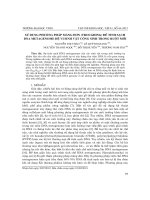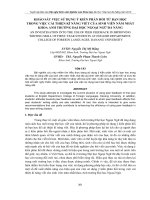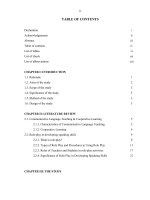SỬ DỤNG PHƯƠNG THỨC ĐỌC MỞ RỘNG ĐỂ CẢI THIỆN KHẢ NĂNG ĐỌC CỦA SINH VIÊN
Bạn đang xem bản rút gọn của tài liệu. Xem và tải ngay bản đầy đủ của tài liệu tại đây (442.82 KB, 6 trang )
<span class='text_page_counter'>(1)</span><div class='page_container' data-page=1>
<b>USING EXTENSIVE READING </b>
<b>TO IMPROVE STUDENTS’ READING ABILITY </b>
<b>Pham Thi Hoang Ngan*, Mai Thi Thanh Thu, Tran Van Dang </b>
<i>Nam Dinh University of Nursing </i>
ABSTRACT
Reading is a source of learning and a source of enjoyment. Especially, in a second foreign
language situation, a good reading ability is necessary for those studying English for academic and
occupational purposes and many universities’curricula. Many previous studies showed that
students devote large amounts of time to reading lessons in order to achieve such competence. Yet
despite years of instruction and practice in reading, plenty of students have difficulty in improving
their reading ability. Of course, there are a number of possible reasons for this such as the lack of
vocabulary, reading fluency and reading habits. There are different ways to improve students’
reading ability and one of them is through Extensive Reading. Therefore, this paper aims to show
problems students face while learning to read and identify benefits of Extensive Reading on
improving students’ reading ability.
<i><b>Key words: extensive reading; reading ability; vocabulary; reading fluency; reading habit </b></i>
<i><b>Received: 06/5/2019; Revised: 23/5/2019; Approved: 29/5/2019 </b></i>
<b>SỬ DỤNG PHƯƠNG THỨC ĐỌC MỞ RỘNG </b>
<b>ĐỂ CẢI THIỆN KHẢ NĂNG ĐỌC CỦA SINH VIÊN</b>
<b>Phạm Thị Hoàng Ngân*<sub>,</sub><sub>Mai Thị Thanh Thu, Trần Văn Đăng</sub></b>
<i>Trường Đại học Điều Dưỡng Nam Định </i>
TÓM TẮT
Đọc là một cách để học tập và hưởng thụ. Đặc biệt, trong việc học ngoại ngữ thứ hai, khả năng đọc
tốt là cần thiết cho việc học tiếng Anh với mục đích học thuật và mục đích nghề nghiệp cũng như
trong nhiều chương trình giảng dạy của các trường đại học. Nhiều nghiên cứu trước đây đã chỉ ra,
sinh viên dành nhiều thời gian đối với các bài học đọc để đạt được năng lực như vậy. Mặc dù có
nhiều năm được hướng dẫn và thực hành về cách đọc, nhiều sinh viên học tiếng Anh vẫn gặp khó
khăn trong việc cải thiện khả năng đọc. Tất nhiên, có một số lý do cho việc này như việc thiếu từ
vựng, đọc lưu lốt và thói quen đọc. Có nhiều cách khác nhau để cải thiện khả năng đọc của sinh
viên và một trong số đó là phương thức “đọc mở rộng”. Do đó, bài báo nhằm mục đích chỉ ra các
vấn đề mà sinh viên gặp phải trong khi học đọc và tìm ra lợi ích của việc “đọc mở rộng” đối với
việc cải thiện khả năng đọc của sinh viên.
<i><b>Từ khóa: đọc mở rộng; khả năng đọc; từ vựng; đọc lưu lốt; thói quen đọc </b></i>
<i><b>Ngày nhận bài: 06/5/2019; Ngày hoàn thiện: 23/5/2019; Ngày duyệt đăng: 29/5/2019 </b></i>
</div>
<span class='text_page_counter'>(2)</span><div class='page_container' data-page=2>
<b>1. Introduction </b>
Reading ability which refers to reading
comprehension and speed is very important in
our daily life and studies including EFL
(English as a Foreign Language) courses. The
aim of the syllabus of English for Nurses at
Nam Dinh University of Nursing (NDUN) is
that students will be able to read specific
documents in English after an English course
face to face. In fact, this aim seems not to be
achieved because many students have
difficulties in making sense of texts they want
to read at the end of the course and even at
their work in the future. The main reasons for
their bad reading are: they lack vocabulary,
reading fluency and reading habit. Thus, the
question most teachers of English often
concern about is how they can help their
students overcome these problems so that
they can improve their reading ability.
Extensive reading has been considered to be
an indispensable means of developing
students’ reading ability [1]. Day and
Bamford [2] defined extensive reading in a
second language (L2) as “an approach to the
teaching and learning of second language
reading in which learners read large quantities
of books and other materials that are well
within their linguistic competence”. So far,
many researchers such as Horst [3], Pigada &
Schmitt [4] and Soltani [5] etc have provided
evidence for the benefits of extensive reading
on language learning including reading
ability. Therefore, this paper is going to
identify some common problems that students
have while learning to read and how can
extensive reading solve these problems to
improve their reading ability.
<b>2. Problems students usually face while </b>
<b>learning to read </b>
<i><b>2.1. The lack of vocabulary </b></i>
If reading has been considered to be a
significant and viable means of language
development for second and foreign language
learner by Day and Bamford [2], vocabulary
plays an important role in reading. Most
second language readers would affirm that
their main obstacle to reading is their lack of
vocabulary. Wang [6, p. 47] also stated that
“Many students probably consider that their
main problem in reading is not having enough
vocabulary.” According to Hsueh-chau and
Nation [7], most learners would need to know
about 98% of the words in a text before they
are be able to guess the meaning of a word
from its context. This seems to be difficult for
students because many of them do not have
enough vocabulary like that. The results from
the study made by a group of authors Mokhtar
et al. [8] has shown that the majority of the
students are still weak in terms of their English
passive and active vocabulary knowledge.
Then this lack of vocabulary makes it difficult
for them to guess the meanings of words in
context and cannot do reading comprehension
well. Besides, this is the reason why many
students use their dictionaries for the meaning
of words so that they feel tired and time
consuming. Furthermore, when they look up
words in the dictionary, they often feel
frustrated and confused by what they find since
sometimes meanings in it are very common. In
other words, that causes decrease of their
reading speed.
<i><b>2.2. The lack of reading fluency </b></i>
</div>
<span class='text_page_counter'>(3)</span><div class='page_container' data-page=3>
comprehension. From my experience of
teaching English, I found that students often
read texts without fluency. They read words
by words slowly without accuracy and do not
understand expressions in the texts.
Explaining for this situation, teachers find
that reading lessons in textbooks for L2
students do not aim at improving students’
reading fluency. They often read texts in
silent and do not take care of time or accuracy
of reading. Then they try to translate them
into L1. Besides, English is usually taught in
large classes so teachers do not have enough
time to ask each student to read aloud the
texts and to give them good feedbacks.
<i><b>2.3. The lack of reading habit </b></i>
Although many students know that reading
everyday seems to be the best way to read
well, they still do not have good reading
habit, especially in L2. In my previous study
on self-study, 478 students at my university
were asked “Do you have any books to read
more apart from the one you have to use in
the course?”, 3,5 % of these students
answered “Yes”. That means most students
do not have habits of reading. Students who
seldom read had a much lower average score
than students who often read.
Explaining for their lack of reading habits, the
students said that with a small amount of
vocabulary they have, the texts in their books
were often difficult for them to understand
and sometimes they were not their interesting
topics. After reading difficult texts without
understanding and enjoyment, they begin to
lose motivation and pleasure for reading. In
addition to this, at school where English is not
the main subject, there are few books,
newspapers or magazines in English which
are suitable for them to read outside classes.
Gradually, they are afraid of reading and
cannot create reading habit for themselves.
<b>3. Extensive reading – one way to deal with </b>
<b>the above mentioned problems </b>
It is probable that the above-mentioned
problems are in vicious circle. Students’
reading abilities are bad because of lacking
vocabulary, frequency and reading habit. It
doesn’t matter where you enter the problem
because any of the problems will produce any
of the others. For example, students who do
not have enough vocabulary and frequency in
reading will do not have reading habit and
verse. Thus, it is necessary to solve all the
problems at the same time. In fact, there are
many ways to improve students’ vocabulary,
reading fluency and reading habit separately.
However, extensive reading is considered to
be the best way as it can solve these problems
at the same time. Richard and Schmidt (2002)
report that extensive reading is tended to
develop good reading habits, to build up
knowledge of vocabulary and encourage a
liking for reading [11].
<i><b>3.1. Extensive reading can increase vocabulary </b></i>
In fact, not all of words are learnt by being
taught, most of them were learnt when
students meet them in the context. Usually
this involved assimilating the meaning
gradually, after frequent encounters. In the
classroom, students do not get enough
exposure for this natural assimilation to be
possible. Therefore, solutions outside should
be found. Wang [6] indicates that the most
effective way of improving vocabulary is
extensive reading.
</div>
<span class='text_page_counter'>(4)</span><div class='page_container' data-page=4>
with explicit teaching during the relatively
short period of time that L2 learners spend in
the language classroom [13]. Besides,
extensive reading can also encourage students
to gain new vocabulary through reading and
thus their vocabulary recognition is built
naturally. In the study by Lai (1993) (cited in
[13]), the findings showed that there were
three experimental groups which displayed
better scores in vocabulary recognition
compared to the control groups. Furthermore,
there is no reason to doubt the finding that
students incidentally gain small amounts of
vocabulary knowledge from each meaning
focused reading an appropriate text and with
the characteristic of an Extensive reading
approach such as students read as much as
possible, that will help students remember their
vocabulary for a long time. It is obvious that
extensive reading can help students develop
vocabulary. Educators and researchers have
known that there is a strong correlation
relationship between vocabulary development
and reading comprehension. The more words
students know in the reading texts, the better
they comprehend the texts. Moreover, this also
helps them improve their reading speed
because they can guess the meanings of other
new words quickly and do not waste of time
looking words up in the dictionary.
<i><b>3.2. Extensive reading deals with fluency </b></i>
<i><b>problem </b></i>
A number of researchers indicate that good
reading ability is virtually impossible in the
absence of reading fluency. Therefore,
efficient ways of increasing reading fluency
must be found to improve reading ability.
According to Day and Bamford [14]
Extensive reading promotes reading fluency.
As students are asked to read a large amount
of comprehensive materials, speed becomes
important to facilitate the enjoyment and
comprehension of materials. In studies on
reading rate, extensive reading has been
shown to increase students’ reading speed.
Iwahori’s study [15] showed that students’
reading rates improved after a 7-week
extensive reading treatment. The meaning
reading rate from the pretest to the posttest
improved from 84.18 to 112.82. Besides,
decoding words automatically is needed for
reading fluency. Words that students can
recognize rapidly accurately and
automatically have been called sight
vocabulary. Sight vocabulary is essential for
improving reading fluency. When students
have a great deal of sight vocabulary, they
can decode more words automatically. As a
result, they can save their finite cognitive
resources to comprehend a text. Also, sight
vocabulary was proven to be increased by
extensive reading above. That means
extensive reading can improve students’
reading fluency.That means extensive reading
can improve students’ reading fluency. With
specific reference to reading fluency
development, extensive reading has shown to
be effective in increasing their reading speed
and comprehension [16].
<i><b>3.3. Extensive reading creates reading habit </b></i>
Lacking reading habit is one of students’
problems mentioned above. Students do not
have interest in reading partly because their
vocabulary and reading fluency is not good
enough. After these problems are solved by
extensive reading, students’ are more
confident in reading. In other words,
extensive reading indirectly improves
students’ reading ability. Furthermore, to
have reading habits students also need to have
pleasure and motivation.
</div>
<span class='text_page_counter'>(5)</span><div class='page_container' data-page=5>
wide range of topic is available to encourage
students to read for different reasons and in
different ways; students select what they want
to read and have freedom to stop if they are not
interested in them; and the purposes of reading
are usually related to pleasure.
One of the key factors to make students have
reading habits is good attitude and
motivation. Day and Bamford [2] reported
that positive effects of extensive reading are
facilitating growth of student’s attitudes
toward reading and increasing their
motivation to read. Since extensive reading
supplies materials that are interesting to the
students, they will be far more likely to be
stimulated motivation to read. In addition, the
findings of previous research prove the effect
of extensive reading on learners’ attitudes
towards reading in the second language.
Likewise, with motivation to read and good
attitude to reading students will gradually
have reading habit everyday. Perhaps this is
because the more one reads, the easier reading
becomes.
<b>4. Discussion </b>
On the whole, extensive reading with its
characteristics has helped students overcome
their difficulties in learning to read. The
reason why extensive reading is considered to
be better than the other methods on improving
reading ability is that it can solve students’
difficulties at the same time. It is very likely
that their reading abilities will increase in the
long term if this reading is kept up and
students are supplied with suitable materials
and attention from their teachers.
However, students at NDUN have faced a
number of challenges in using Extensive
reading including lack of time, shortage of
appropriate reading materials. Furthermore,
English is taught at the first year while the
students have not adapted to new learning
environment. They seem to be too busy to
have time for reading something apart from
their course books. Also, their levels of
English are not the same so the teachers find
it difficult to provide them the appropriate
reading material. Moreover, the reading
materials are not available in the library.
Therefore, the teachers play crucial roles for
the sucessess of the approach. They should
introduce the Extensive Reading programme
to their students, help students to choose
appropriate books, encourge students to read
as much as possible, and monitor students’
reading as well as reward them if they reach
the target number of books.
<b>5. Conclusion </b>
In conclusion, this paper has pointed out that
students’ lack of vocabulary, reading fluency
and reading habit are three major problems
that students are likely to encounter, which
make them entangle in vicious circle of
reading, then become bad readers. Although
extensive reading is not without problems, it
is considered to be able to deal with all these
problems which help students improve their
reading ability. However, extensive reading is
still the missing ingredient in the EFL context
of Vietnamese universities. Due to this
situation, this paper was written with the hope
that teachers and students in Vietnam will
have right perception about the role of
extensive reading and will apply it on
improving students’ reading ability.
REFERENCES
[1]. Sheu, S.P., “The effects of Extensive reading
on learners’ reading ability development,”
<i>Journal of National Taipei Teachers College, </i>
<i>vol 17, no. 2, pp.213-228, 2004. </i>
<i>[2]. Day, R. R. and Bamford, J., Extensive reading </i>
<i>in </i> <i>the </i> <i>second </i> <i>language </i> <i>classroom. </i>
Cambridge: Cambridge University Press,
1998.
[3]. Horst, M., “Learning L2 Vocabulary through
Extensive Reading: A measurement Study,”
<i>The Canadian Modern language Review, vol. </i>
61, no. 3, pp. 355-382, 2005.
</div>
<span class='text_page_counter'>(6)</span><div class='page_container' data-page=6>
<i>study,” Reading in a Foreign Language, vol. </i>
18, no. 1, 2006.
[5]. Soltani, R., “Extensive Reading A Stimulant
<i>to Improve Vocabulary Knowledge,” Studies </i>
<i>in literature and Language, vol. 2, no.3, pp. </i>
161-167, 2011.
[6]. Wang, L., “How to improve students’ reading
<i>ability,” US-China education review, vol.3, </i>
no.5, pp.47-51, 2006.
[7]. Hsueh-chau, M. H. & Nation, P., “Unknown
vocabulary density and reading
<i>comprehension,” Reading in a Foreign </i>
<i>Language, vol. 13, no. 1, pp.403-430, 2000. </i>
[8]. MohdAsraf, R & Ahmad, I. S., “Promoting
English language development and the
reading habit among students in rural schools
through the Guided Extensive Reading
programme,” <i>Reading </i> <i>in </i> <i>a </i> <i>Foreign </i>
<i>Language, vol. 15, no. 15, pp.84-102, 2010. </i>
[9]. Dunn, M., “Reading fluency: What, Why, and
<i>How?”.[Online].Available:</i>
g/dbs/roadmap/files/.../news-fluency.
[Accessed Sept 11, 2010].
[10]. Grabe, W., “Fluency in reading-thirty-five
<i>years later,” Reading in a Foreign Language, </i>
vol. 22, no. 1, pp.71-83, 2010.
[11]. Meng, F., “Developing Students’ Reading
<i>Ability through Extensive Reading,” English </i>
<i>Language Teaching, vol. 2, no. 2, pp.132-137, </i>
2009.
[12]. Hafiz, F.M. & Tudor, I., “Extensive reading
and the development of language skills,” ETL
journal, vol. 34, no. 1, pp. 5-13, 1989.
[13]. Pigada, M. & Schmitt, N., “Vocabulary
acquisition from extensive reading: A case
<i>study,” Reading in a Foreign Language, vol. </i>
18, no. 1, 2006.
[14]. Day, R. R., & Bamford, J., “Top ten
principles for teaching extensive reading,”
<i>Reading in a Foreign Language, vol.14, </i>
pp.136–141, 2002.
[15]. Iwahori,Y., “Developing reading fluency: A
<i>study of extensive reading in EFL,” Reading </i>
<i>in a Foreign Language, vol. 20, no. 1, </i>
pp.70-91, 2008.
</div>
<!--links-->









